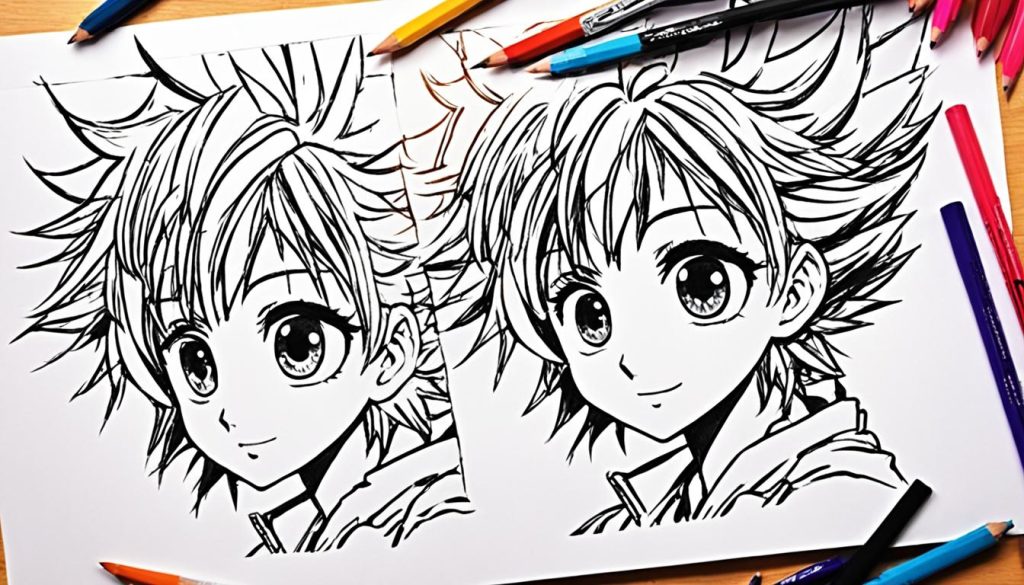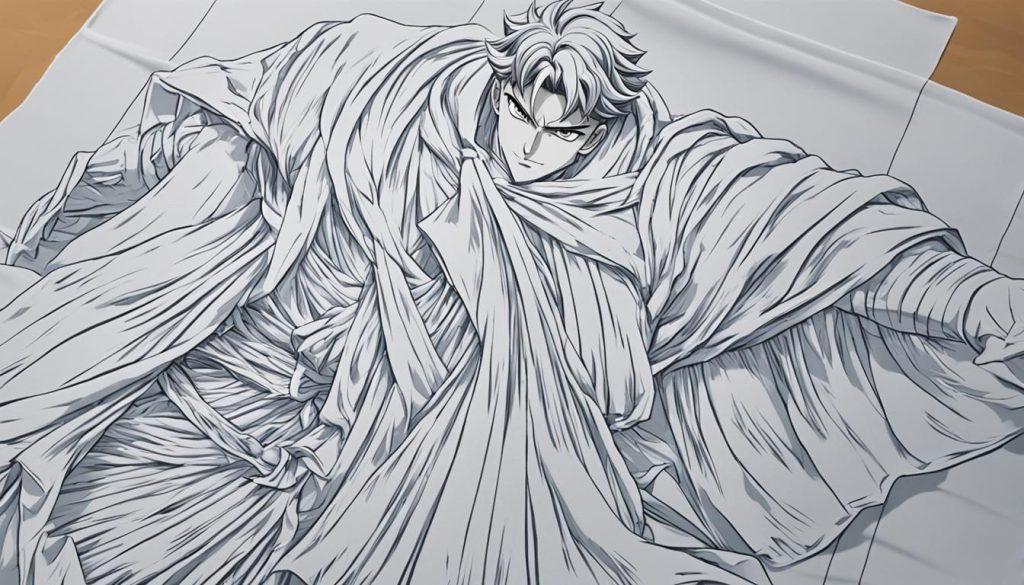Welcome to our guide on how to draw anime! Whether you’re a beginner or looking to enhance your skills, this article will provide you with valuable tips and techniques to create stunning anime artwork. From step-by-step tutorials to beginner-friendly drawing tips, we’ll cover everything you need to know to bring your favorite anime characters to life.
Learning how to draw anime can be an exciting and rewarding journey. By understanding the fundamentals of drawing, such as perspective and anatomy, and mastering shading techniques and color theory, you’ll be able to create anime characters that are both captivating and realistic.
Throughout this guide, we’ll provide you with step-by-step anime drawing tutorials, expert tips, and valuable resources to help you on your artistic journey. So, whether you’re a fan of action-packed shonen anime or adorable slice-of-life shows, let’s dive in and discover the art of drawing anime!
How to Draw Anime?
Learn the Basics of Drawing
Before diving into the world of anime drawing, it’s crucial to establish a strong foundation in the basics of drawing. By mastering these fundamental techniques, you’ll be able to bring your anime artwork to life with confidence and creativity. Here, we’ll explore some essential tips and techniques for beginners in anime drawing.
1. Practice with Simple Shapes and Lines
One of the first steps in improving your drawing skills is to practice with simple shapes and lines. This helps you develop precision, control, and a better understanding of form. Start by drawing basic geometric shapes like circles, squares, and triangles. Experiment with different line weights to create depth and dimension in your drawings.
2. Seek Guidance from Tutorials and Guides
Thanks to the internet, there is a plethora of valuable resources available to help beginners in their anime drawing journey. Take advantage of tutorials and guides that provide step-by-step instructions on drawing anime and manga characters. These resources can provide valuable insights into proportions, facial expressions, and other essential elements of anime art.
One such tutorial that can be beneficial for beginners is “How to Draw Anime: A Step-by-Step Guide for Beginners.” This comprehensive guide covers everything from basic anatomy to shading techniques, giving you a solid foundation in anime drawing.
3. Develop Sketching Techniques
Sketching is an integral part of the anime drawing process. It allows you to plan and refine your artwork before adding final details and colors. Experiment with different sketching techniques, such as hatching, cross-hatching, and stippling, to add texture and depth to your drawings. Practice sketching various anime characters, focusing on capturing their unique features and expressions.

By incorporating these basic techniques into your drawing practice, you’ll gradually build your skills and gain confidence in creating anime artwork. Remember, becoming a proficient anime artist takes time and dedication, so be patient with yourself and enjoy the process of learning and growing as an artist.
Mastering Perspective Drawing
Perspective drawing is a fundamental skill that every anime artist should master. It allows you to create realistic and dynamic artwork by accurately depicting the way objects appear smaller as they recede into the distance. By understanding and applying perspective, you can bring depth and dimension to your anime characters, eyes, and clothing folds.
Understanding the Basics
Before diving into perspective drawing, it’s important to familiarize yourself with the basic principles. Remember, perspective is all about creating the illusion of depth and space in your artwork. Here are some key concepts to keep in mind:
- Vanishing Point: The point where parallel lines appear to converge. It’s the key element that dictates the direction and magnitude of foreshortening.
- Horizon Line: The horizontal line that represents eye level. Objects above the horizon line will appear lower in the drawing, while objects below it will appear higher.
- Orthogonal Lines: Diagonal lines that converge towards the vanishing point, helping to create the illusion of depth.
Drawing Three-Dimensional Objects
Practicing with three-dimensional objects from different angles is an excellent way to develop your perspective drawing skills. Start by observing everyday objects such as cubes or spheres and sketching them from various viewpoints. Focus on capturing the correct proportions, foreshortening, and placement within the overall composition.
To further enhance your understanding of perspective, consider using reference material and studying how perspective is applied in professional anime artwork. Analyze the way the background, characters, and objects interact in the scene, paying attention to the vanishing points and the sense of depth they create.

Bringing Perspective to Anime Characters
Perspective drawing is not limited to inanimate objects; it also plays a crucial role in portraying realistic and dynamic anime characters. By applying perspective principles to features such as eyes and clothing folds, you can add a sense of depth and realism to your character designs.
When drawing anime eyes, consider the position of the character’s head and the angle at which they are looking. Use perspective to shape the iris and pupil, making them appear as if they are receding into the eye socket.
For clothing folds, concentrate on capturing how fabric clings, hangs, and drapes over the character’s body. Vary the width and intensity of folds based on the tension and gravity affecting the garment. Understanding perspective will help you accurately render the folds, making the clothing look more natural and believable.
| Eye Angle | Examples |
|---|---|
| Straight On | |
| Looking Up | |
| Looking Down |
With practice and a solid understanding of perspective drawing, you can elevate your anime artwork to the next level. Remember, mastering perspective takes time and patience, so embrace the learning process and enjoy the journey of enhancing your anime drawing skills.
Understanding Basic Anatomy
While anime characters often have exaggerated proportions, having a basic understanding of anatomy is essential for creating believable and well-structured drawings. By learning about the proportions and placement of different body parts, you can avoid common mistakes and bring your anime characters to life.
Drawing Cute Anime Characters
When drawing cute anime characters, it’s important to capture their unique features and expressions. Pay attention to their oversized eyes, rounded faces, and small noses and mouths. Add soft, curved lines to create a sense of innocence and charm. Tutorials focused on drawing cute anime characters can provide valuable insights into mastering this adorable style.
Drawing Chibi Anime Characters
Chibi anime characters are characterized by their short, stubby bodies and oversized heads. To draw chibi characters, start by sketching a smaller body with simple shapes and then exaggerate the head and facial features. Remember to include large, expressive eyes, tiny noses and mouths, and cute little limbs. Exploring tutorials dedicated to drawing chibi anime characters can help you refine your technique and create delightful artwork.
Developing your skills in anime character drawing involves continuous practice and study. A solid understanding of basic anatomy, combined with the ability to depict cute anime characters and chibi anime characters, will give your drawings personality and charm. Keep honing your skills and exploring different styles to unlock your full creative potential.
Mastering Shading and Color
Shading is an essential technique that adds depth and realism to your anime drawings. By understanding how light interacts with objects, you can effectively shade your artwork and create realistic lighting conditions. This skill allows you to give your characters a three-dimensional appearance and bring them to life.
When shading, it’s important to consider the direction of the light source and the form of the object. Shadows can help define the shape and volume of your characters, while highlights can add emphasis and create contrast. By practicing different shading techniques, such as hatching or cross-hatching, you can achieve various effects and enhance the overall quality of your drawings.
Colour is another aspect that plays a significant role in anime art. Learning color theory and how to use warm, cool, and complementary colors can greatly enhance your artwork. Experiment with different color schemes to create appealing and vibrant anime characters.
To further improve your skills in shading and color, explore tutorials and guides that focus on specific aspects of anime drawing. Whether it’s shading anime faces, mastering the art of drawing anime eyes, or creating full-body drawings, these resources can provide valuable insights and techniques to enhance your artwork.
Tutorial: Shading Anime Eyes
The eyes are one of the most important features in anime characters. Properly shading the eyes can add depth and expressiveness to your drawings. This tutorial will guide you step-by-step on how to shade anime eyes and achieve realistic and captivating results.
| Steps | Description |
|---|---|
| 1 | Start by drawing the basic shape of the eye, including the iris and pupil. |
| 2 | Identify the light source and determine the direction of the shadows. |
| 3 | Using a light pencil, lightly shade the eyelids and areas that are receding from the light source. |
| 4 | With a darker pencil, add shading to the areas that are closer to the light source and in the creases of the eye. |
| 5 | Blend the shading using a blending stump or a soft brush to create a smooth transition between light and shadow. |
| 6 | Add highlights to the eyes using a white gel pen or a light-colored pencil to make them shine. |
| 7 | Refine the details, such as the eyelashes and the reflections in the eyes, to complete the shading process. |
Conclusion
Drawing anime is a journey that requires dedication and practice. By following the step-by-step tutorials and easy drawing techniques provided in this article, you can develop your skills and create stunning anime artwork. Whether you want to draw anime girls, anime boys, or focus on mastering anime eyes and bodies, there are resources available to help you on your artistic journey.
Remember, drawing anime is not just for adults. Kids can also benefit from learning to draw their favorite anime characters. With age-appropriate tutorials and guidance, children can express their creativity and develop their artistic abilities.
Referencing an anime drawing book can provide additional guidance and inspiration. These books often feature detailed explanations and illustrations, making them valuable resources for both beginners and more experienced artists looking to improve their skills. Keep practicing and experimenting with different styles and techniques, and with time and effort, you can become a proficient anime artist and create captivating artwork that showcases your unique creativity.
FAQs
Why is perspective drawing important in anime?
Perspective drawing is crucial in creating realistic and dynamic anime artwork. It involves understanding how objects appear smaller as they recede into the distance. Practicing three-dimensional drawings from different angles will enhance your ability to draw complex anime characters, eyes, and clothing folds.
How can I improve my anatomy in drawing anime?
Having a basic understanding of anatomy is essential for creating believable and well-structured anime drawings. You can improve your anatomy skills by learning about the proportions and placement of different body parts. Tutorials focused on drawing cute anime characters and chibi anime characters are also helpful in capturing the unique features of these styles.
What role does shading play in anime drawings?
Shading adds depth and realism to your anime drawings. By understanding how light interacts with objects, you can effectively shade your drawings and create realistic lighting conditions. Learning color theory and the use of warm, cool, and complementary colors will also help you create vibrant and appealing anime characters.
How can I become a proficient anime artist?
Becoming a proficient anime artist requires dedication and practice. By following the tips and techniques outlined in this article and exploring tutorials, you can develop your skills and create stunning anime artwork. Remember to be patient with yourself and continue learning and experimenting with different styles and techniques.

